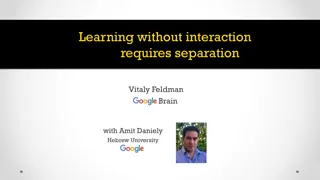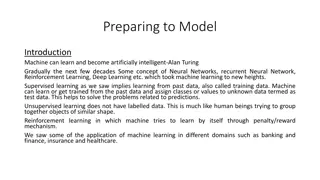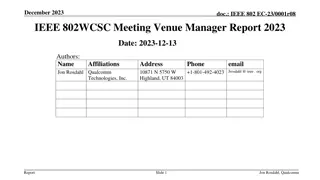Exploring Machine Learning Applications in Enhancing 802.11 Performance
This document delves into recent research on utilizing machine learning (ML) to enhance 802.11 performance, focusing on emerging use cases and the increased interest in ML applications in the field since 2019. It outlines the ML areas frequently used, such as supervised learning (SL) and reinforcement learning (RL), and how ML is leveraged to optimize 802.11 parameters. Additionally, the presentation discusses the core features of 802.11 that ML is used to enhance, including channel access, link configuration, and PHY-related aspects. Notably, the document showcases an example use case of Deep Reinforcement Learning in configuring contention window (CW) values at the Access Point (AP).
- Machine Learning
- 802.11 Performance
- Emerging Use Cases
- Wireless Networking
- Deep Reinforcement Learning
Download Presentation

Please find below an Image/Link to download the presentation.
The content on the website is provided AS IS for your information and personal use only. It may not be sold, licensed, or shared on other websites without obtaining consent from the author. Download presentation by click this link. If you encounter any issues during the download, it is possible that the publisher has removed the file from their server.
E N D
Presentation Transcript
July 2022 Applying ML to 802.11: Current Research and Emerging Use Cases Date: 2022-07-13 Authors: doc.: IEEE 802.11-22/0979r1 Submission Slide 1 Szymon Szott, AGH University
July 2022 doc.: IEEE 802.11-22/0979r1 Abstract In this contribution, we give an overview of recent research into applying ML to improve 802.11 performance. Then, we define emerging use cases and discuss how they can be supported by the 802.11 standard. Submission Slide 2 Szymon Szott, AGH University
July 2022 doc.: IEEE 802.11-22/0979r1 Presentation Scope Based on recent survey [1] Only 802.11 performance improvement Out-of-scope areas Security (e.g., detecting attacks) Energy efficiency (e.g., power saving) Dedicated applications of 802.11 Device positioning Human activity detection Wireless sensing [1] S. Szott et al., "Wi-Fi Meets ML: A Survey on Improving IEEE 802.11 Performance with Machine Learning," in IEEE Communications Surveys & Tutorials, doi: 10.1109/COMST.2022.3179242. Submission Slide 3 Szymon Szott, AGH University
July 2022 doc.: IEEE 802.11-22/0979r1 Research Interest in ML & 802.11 Increased research interest in applying ML to improve 802.11 performance, especially since 2019 Submission Slide 4 Szymon Szott, AGH University
July 2022 doc.: IEEE 802.11-22/0979r1 Which ML areas are used? SL and RL are frequently used, while UL is less popular. The most often used ML mechanisms are Q-learning, multi-armed bandit, as well as different neural network types (mostly ANN, DNN, and CNN), usually implemented to optimize a constrained set of 802.11 parameters. With the increase in available computing power, DL methods are gaining in popularity. Federated learning and transfer learning are a recent introduction in the 802.11 domain. Submission Slide 5 Szymon Szott, AGH University
July 2022 doc.: IEEE 802.11-22/0979r1 How is ML used? Mostly to find good configurations of 802.11 parameters Core 802.11 features Channel access (e.g., collision reduction) Link configuration (e.g., rate adaptation) PHY-related (e.g., interference management) Recent 802.11 features Beamforming (e.g., beam selection) Multi-user communication (e.g., RU scheduling) Spatial reuse (e.g., select transmit power) Channel bonding (e.g., select channel and bandwidth) Submission Slide 6 Szymon Szott, AGH University
July 2022 doc.: IEEE 802.11-22/0979r1 Example Deep Reinforcement Learning Use Case [2] An agent at the AP configures CW values (action) based on collision probability measurements (observation) to increase network throughput (reward). Submission Slide 7 Szymon Szott, AGH University
July 2022 doc.: IEEE 802.11-22/0979r1 Example Use Case Cont d [2] As the number of contending stations steadily increases over time (left), the AP monitors the collision probability and uses RL to select the CW value for all associated stations to maintain throughput higher than under legacy operation (right). The example shows two RL algorithms that use different types of output (DQN discrete, DDPG continuous) and which explore the available parameter space in search of better CW values (left). [1] Submission Slide 8 Szymon Szott, AGH University
July 2022 doc.: IEEE 802.11-22/0979r1 Channel Access Control Popular area of research Application of ML Select CW value Or CWmin Together with AIFS Select CW update rule Select time slot for transmission ML category: mostly RL ML improvement: higher throughput Submission Slide 9 Szymon Szott, AGH University
July 2022 doc.: IEEE 802.11-22/0979r1 Link Adaptation Application of ML Select transmission rate Classify channel type Predict link-layer throughput ML category Mostly RL but also SL (e.g., Random Forest) ML improvement: higher throughput Submission Slide 10 Szymon Szott, AGH University
July 2022 doc.: IEEE 802.11-22/0979r1 PHY Features Application of ML Decode frames Classify signal source De-noise signals Estimate interference level ML category: mostly SL ML improvement: high accuracy Submission Slide 11 Szymon Szott, AGH University
July 2022 doc.: IEEE 802.11-22/0979r1 Beamforming Possible observations: Current SNR levels, historical SNR levels, camera images, etc. Application of ML Select Beam sector Beamwidth Transmit power AP Classify channel type Predict channel characteristics Select transmission rate ML category: mostly SL ML improvement higher throughput, reduced exploration time Machine Learning Actions: Beam sector selection AP Submission Slide 12 Szymon Szott, AGH University
July 2022 doc.: IEEE 802.11-22/0979r1 Multi-User Communication Application of ML Select users, spatial mode, transmission rate Schedule RUs Select MU-MIMO group ML category: both SL and RL ML improvement: higher throughput Submission Slide 13 Szymon Szott, AGH University
July 2022 doc.: IEEE 802.11-22/0979r1 Spatial Reuse Application of ML Select channel and transmit power Select carrier sense threshold, transmission rate and power Decide whether to transmit concurrently ML category: mostly RL ML improvement: higher throughput, lower latency Submission Slide 14 Szymon Szott, AGH University
July 2022 doc.: IEEE 802.11-22/0979r1 Channel Bonding Application of ML Select channel and bandwidth Predict throughput Decide whether to transmit concurrently ML category: mostly RL ML improvement Higher throughput Lower latency Submission Slide 15 Szymon Szott, AGH University
July 2022 doc.: IEEE 802.11-22/0979r1 Other Areas Predicting traffic and link quality Channel sharing with other technologies (LAA, NR-U) Multi-hop networks Ad hoc (e.g., routing) Mesh (e.g., AP selection) Sensor (e.g., select 802.11ah RAW values) Vehicular (e.g., location prediction-based scheduling) More details in [1] Submission Slide 16 Szymon Szott, AGH University
July 2022 doc.: IEEE 802.11-22/0979r1 Future Research Directions Optimizing new 802.11 features Multi-link operation Joint parameter optimization E.g., transmit power and carrier sensing threshold Embedding ML in 802.11 features ML-based architectures and standardized interfaces Reference evaluation scenarios Distributed learning Mandatory 802.11 WG involvement Submission Slide 17 Szymon Szott, AGH University
July 2022 doc.: IEEE 802.11-22/0979r1 Emerging Use Cases Use case #1. ML-based 802.11 parameter selection Observe/monitor network Select (quasi-static) values Use/disseminate new values Control loop Use case #2. ML-based logic installation Install pre-trained agents Network controllers APs AP STAs Submission Slide 18 Szymon Szott, AGH University
July 2022 doc.: IEEE 802.11-22/0979r1 802.11 Support for ML Use Cases (1) Use case #1. ML-based 802.11 parameter selection Example of good support: rate selection Well defined action space (set of MCS values) Independent behavior of each STA Small possibility of misuse Example of poor support: CW selection Clear but rigid behavior in 802.11 spec No room for independent behavior Possibility for misuse select CW selfishly [3] Submission Slide 19 Szymon Szott, AGH University
July 2022 doc.: IEEE 802.11-22/0979r1 802.11 Support for ML Use Cases (2) Use case #1. ML-based 802.11 parameter selection Questions for TIG: Rate selection has good interface Does the 802.11 std provide sufficient interfaces for configuring other parameters? CW selection is rigid Can parameter selection rules be relaxed in the standard? Can the std define ranges instead of single values? Proposal: define an API for RL applications optimizing 802.11 ns3-gym, the interface between ns-3 (802.11 simulator) and OpenAI Gym (RL) has been successful [4] Submission Slide 20 Szymon Szott, AGH University
July 2022 doc.: IEEE 802.11-22/0979r1 802.11 Support for ML Use Cases (3) Use case #2. ML-based logic installation Requires support for SDN-like behavior [5, 6, 7] Questions for TIG: Is distributing logic in the scope of the 802.11 std? If so, how do we define the supporting architecture? Related Work in other SDOs IETF s Autonomic Networking (RFC 7575) ETSI s Generic Autonomic Networking Architecture [8] Submission Slide 21 Szymon Szott, AGH University
July 2022 doc.: IEEE 802.11-22/0979r1 Summary A survey of the research on applying ML for improving 802.11 performance leads to two use cases: 1. ML-based parameter selection 2. ML-based logic installation (dissemination) The TIG should address the technical feasibility of supporting these use cases within the 802.11 standard. Submission Slide 22 Szymon Szott, AGH University
July 2022 doc.: IEEE 802.11-22/0979r1 References [1] S. Szott et al., "Wi-Fi Meets ML: A Survey on Improving IEEE 802.11 Performance with Machine Learning," in IEEE Communications Surveys & Tutorials, doi: 10.1109/COMST.2022.3179242. [2] W. Wydma ski and S. Szott, "Contention Window Optimization in IEEE 802.11ax Networks with Deep Reinforcement Learning," 2021 IEEE Wireless Communications and Networking Conference (WCNC), 2021, pp. 1-6, doi: 10.1109/WCNC49053.2021.9417575. [3] S. Szott, M. Natkaniec, and A.R. Pach. "An IEEE 802.11 EDCA model with support for analysing networks with misbehaving nodes." EURASIP Journal on Wireless Communications and Networking 2010 (2010): 1-13. [4] P. Gaw owicz and A. Zubow. "Ns-3 meets OpenAI gym: The playground for machine learning in networking research." In Proceedings of the 22nd International ACM Conference on Modeling, Analysis and Simulation of Wireless and Mobile Systems, pp. 113-120. 2019. [5] G. Bianchi et al.. "MAClets: active MAC protocols over hard-coded devices." In Proceedings of the 8th international conference on Emerging networking experiments and technologies, pp. 229-240. 2012. [6] R. Chaparadza et al., "SDN enablers in the ETSI AFI GANA Reference Model for Autonomic Management & Control (emerging standard), and Virtualization impact," 2013 IEEE Globecom Workshops (GC Wkshps), 2013, pp. 818-823, doi: 10.1109/GLOCOMW.2013.6825090. [7] P. Gallo et al., "CADWAN: A Control Architecture for Dense WiFi Access Networks," in IEEE Communications Magazine, vol. 56, no. 1, pp. 194-201, Jan. 2018, doi: 10.1109/MCOM.2017.1601097. [8] R. Chaparadza et al., "Implementation Guide for the ETSI AFI GANA model: A Standardized Reference Model for Autonomic Networking, Cognitive Networking and Self-Management," 2013 IEEE Globecom Workshops (GC Wkshps), 2013, pp. 935-940, doi: 10.1109/GLOCOMW.2013.6825110. Submission Slide 23 Szymon Szott, AGH University























